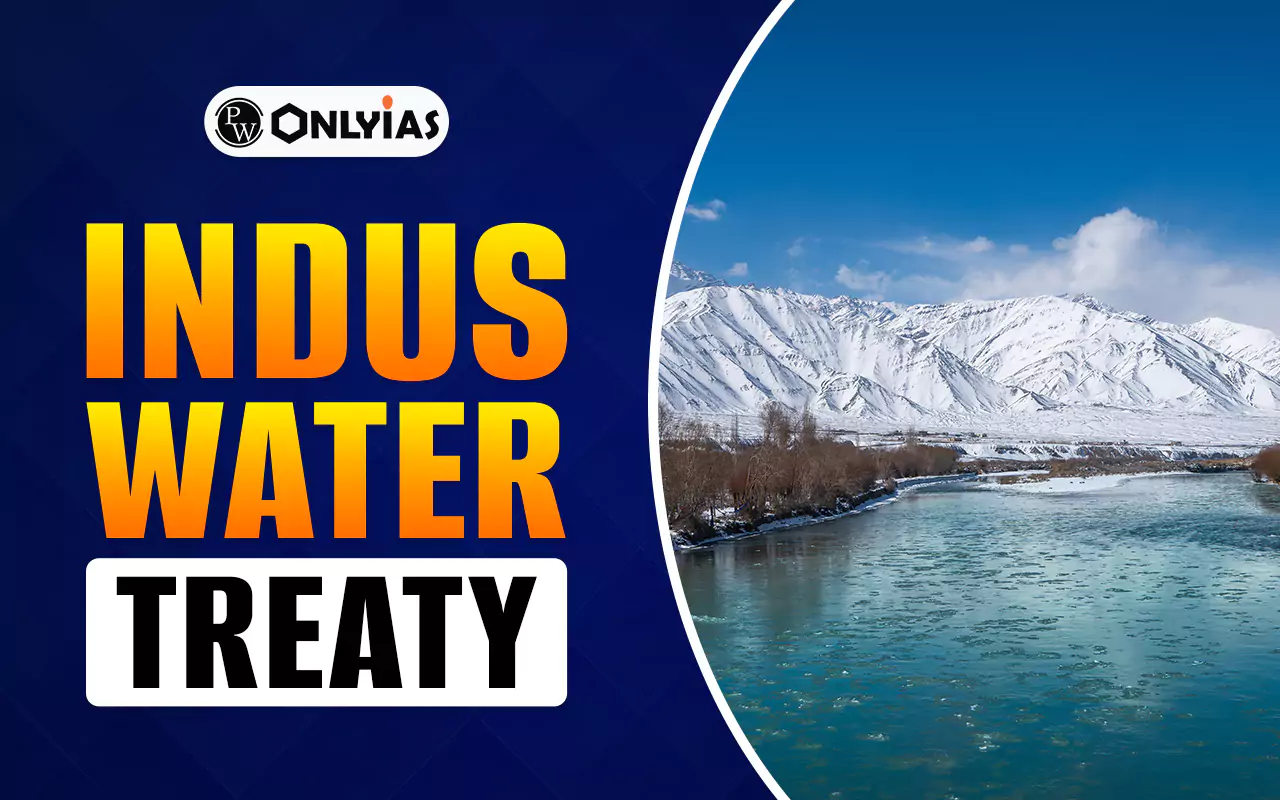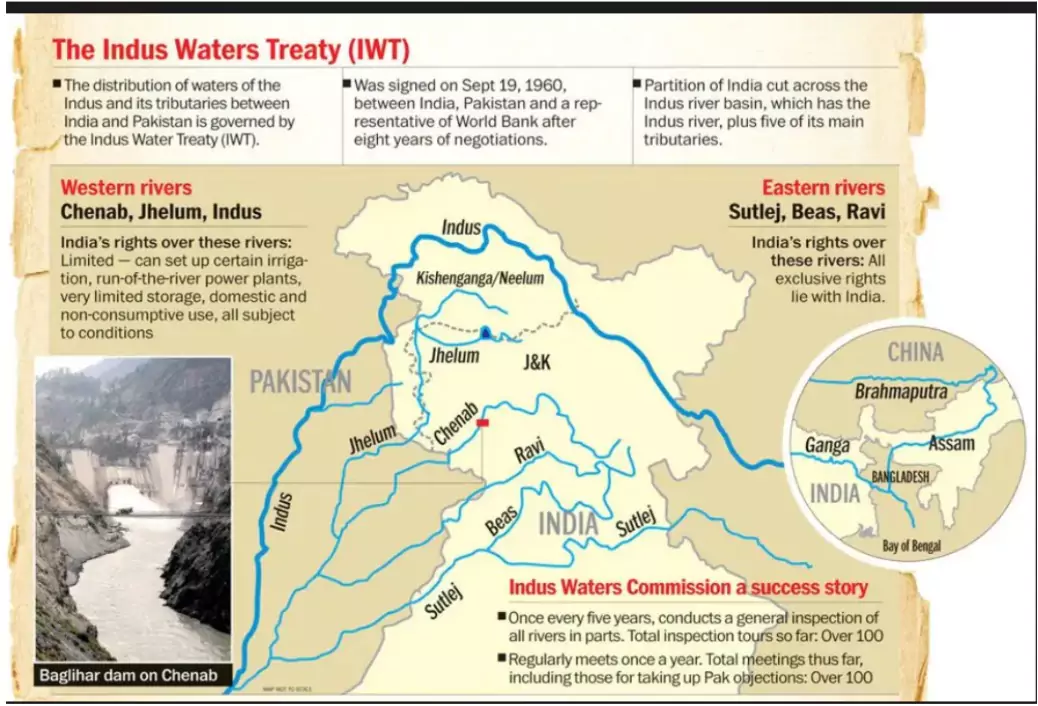The Indus Water Treaty, signed in 1960 between India and Pakistan with World Bank support, divides the Indus river system—eastern rivers (Ravi, Beas, Sutlej) to India and western rivers (Indus, Jhelum, Chenab) to Pakistan. In April 2025, India suspended the treaty after the Pahalgam attack.

Indus Water Treaty, which was signed in 1960 between India and Pakistan and brokered by the World Bank, governs the sharing of the Indus River system waters. It granted the use and allocation of the three eastern rivers (Ravi, Beas and Sutlej) to India and the three western rivers (Indus, Jhelum, and Chenab) to Pakistan.
The treaty established a Permanent Indus Commission (PIC) for the purposes of cooperation and dispute resolution and allowed for water use for irrigational, domestic, and industrial purposes. Despite various points of tension, this treaty has allowed for peaceful water sharing for decades. Some issues that have arisen in recent years have interfered with treaty implementation and impacted bilateral relations between the two countries. Ultimately, the treaty is a European Union key basis for Indo-Pak water sharing.
Indus Water Treaty, signed in 1960, is a water-sharing agreement between India and Pakistan. The treaty divides the Indus river system into eastern and western rivers, granting India control over the eastern rivers (Ravi, Beas, Sutlej) and Pakistan control over the western rivers (Indus, Jhelum, Chenab). The treaty was created to prevent disputes and maintain peace by ensuring both countries can use the water fairly for agricultural, domestic, and industrial needs.
The treaty also sets up a Permanent Indus Commission for cooperation and dispute resolution, which helps both sides communicate and resolve any disagreements about water use.
| Q. Present an account of the Indus Water Treaty and examine its ecological, economic and bilateral relation. [200 Words, 12.5 Marks] UPSC CSE 2016 |
|---|
The map of the Indus Water Treaty demonstrates the partition of the six largest rivers of the Indus system.
This division implies that Pakistan enjoys 80 percent of the total waters since the western rivers are the greatest contributors to the waters and India owns 20 percent of the eastern rivers. The treaty permits India to make non-consumptive use of western rivers such as hydropower generation and irrigation under certain restrictions.

The Indus Water Treaty (IWT), signed on September 19, 1960, is a landmark agreement between India and Pakistan, brokered by the World Bank, which governs the distribution and management of the Indus River and its tributaries. The main aim of this treaty is to define the rights and responsibilities of both countries concerning the shared water resources and to provide a clear framework for cooperation, dispute resolution, and sustainable development along the Indus Basin.
The treaty systemically divides the six rivers of the Indus system between the two nations for exclusive usage.
To oversee the treaty’s implementation, both nations established the Permanent Indus Commission (PIC), which is mandated to meet annually. The PIC serves as a regular platform for the exchange of data, information, and technical cooperation on issues concerning the river system, facilitating transparency and confidence-building.
The IWT is notable for its three-tiered dispute resolution process:
The treaty provides a protocol for the inspection, construction, and modification of water infrastructure projects. Notable projects like Pakal Dul, Lower Kalnai, Kishanganga, and Ratle Hydroelectric projects have undergone inspections and international scrutiny based on the IWT guidelines, ensuring neither country’s interests are unfairly compromised.
The provisions above ensure the Indus Water Treaty remains one of the most enduring examples of transboundary water sharing, laying emphasis on cooperation, regular dialogue, and efficient dispute resolution, even in the face of political tensions between India and Pakistan.
The Indus Water Treaty of 1960 is one of the longest-standing water-sharing agreements worldwide. It has survived many tense moments, even wars, and continues to help maintain cooperation over shared rivers despite political conflicts between India and Pakistan. It ensures the river water is shared fairly to support agriculture and livelihoods in both countries.
Recently, in 2025, India suspended the treaty following security concerns, adding complexity to the relationship. This suspension affects water flow from western rivers and has raised discussions about the treaty’s future.
For UPSC or general studies exams, students should focus on the treaty’s main points:
The treaty is often in the media spotlight because of its geopolitical significance. The most recent news is that India cancelled the treaty in 2025, as tensions rose after the Pahalgam terror attack. This nullification of the treaty allows India to have greater control over the western rivers, which takes away Pakistan’s water for farming and cities. The situation remains precarious as both countries must navigate water usage within broader political contexts.
Ready to boost your UPSC 2026 preparation? Join PW’s UPSC online courses today!
It is a 1960 agreement between India and Pakistan to share water from six rivers in the Indus system. It was brokered by the World Bank to prevent conflict and ensure fair water use.
The map illustrates how the six rivers are divided between India and Pakistan, with India controlling the eastern rivers and Pakistan the western rivers.
The treaty grants Pakistan control of the western rivers and India control of the eastern rivers, with cooperation mechanisms and a dispute resolution process to manage water sharing peacefully.
Yes, India suspended the treaty in 2025 due to national security concerns after a terror attack, affecting water-sharing dynamics between the two countries

<div class="new-fform">
</div>